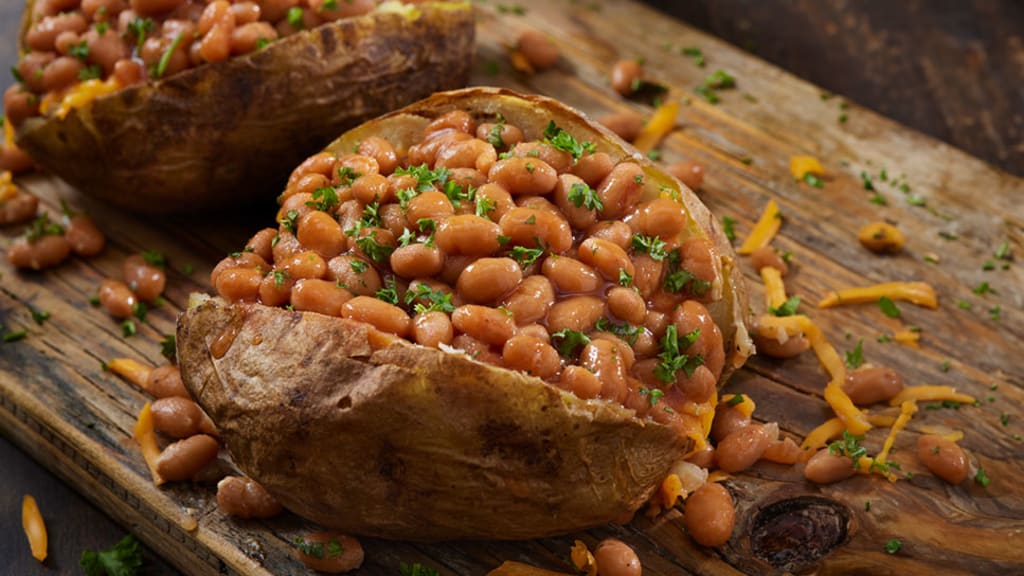Beyond Bananas: 16 Potassium-Rich Foods
For other great sources of this essential mineral, turn to potatoes, squash, lentils, avocados and more

Potassium flies under the radar. Most people don’t think much about this unappreciated mineral, if they think about it at all. But it’s an important nutrient (essential, even), and you may not be getting nearly enough of it.
“Potassium is a mineral that plays a significant role in the function of your heart, kidneys, muscles and nerves,” says registered dietitian Anna Taylor, MS, RDN, LD. “Diets high in potassium-rich foods and low in sodium may reduce the risk of high blood pressure and stroke.”
Taylor shares a few top sources of potassium so you can work more of it into your diet. Your health — and your taste buds — will thank you!
Foods high in potassium
From a fresh fruit salad and a plate of avocado toast, to a fancy fish dinner and a bowl of tomatoey spaghetti, there are so many great ways to get your fill of potassium.
The U.S. Food and Drug Administration (FDA) recommends 3,400 mg of potassium per day for men and 2,600 mg of potassium per day for women, though these guidelines don’t account for differences like sex assigned at birth, height, weight and overall health. For more personalized recommendations, check in with a healthcare provider.
Ready to boost your potassium intake? Here’s how.
Bananas and plantains
OK, OK, we said this list would go beyond bananas. And it will! But first, can we talk about them for juuust a second?
Bananas are probably the one food most associated with potassium, with one medium banana containing about 451 milligrams of potassium. Their close cousins, plantains, have even more of it, coming in at 663 mg per cup.
Eat a plain ol’ banana as a snack, make a side of oven-baked sweet plantains or feature one of them in one of these delicious dishes:
Caribbean-Style Pink Beans With Plantains.
Nutty Banana Muffins.
Sweet Banana Smoothie.
And now … let’s truly go beyond bananas.
Leafy greens
Popeye had the right idea. One cup of the following types of cooked leafy greens packs a wallop of potassium:
Beet greens: 1,309 mg.
Swiss chard: 961 mg.
Spinach: 839 mg.
Kohlrabi: 561 mg.
Broccoli rabe: 550 mg.
It’s easy to add leafy greens to just about any entree, from frittatas and omelets to salads and pastas. But they’re also great as the star of their own side dish:
Chard and Roasted Butternut Squash.
Sautéed Spinach and Tomatoes Over Roasted Spaghetti Squash.
Sautéed Swiss Chard With Slivered Almonds.
Beans
Beans are a great choice for getting your fill of potassium, along with fiber and other nutrients, though the amount varies depending on the type of bean you’re eating:
Lima beans (1 cup, cooked): 969 mg.
Adzuki (red) beans (1/2 cup, cooked): 612 mg.
White beans (1/2 cup, cooked): 502 mg.
Kidney beans (1/2 cup, cooked): 359 mg.
Navy beans (1/2 cup, cooked): 354 mg.
Great Northern beans (1/2 cup, cooked): 346 mg.
If beans make you gassy, consider switching up the type you eat to find a variety that’s easier on your stomach. You can also soak dry beans overnight, which may help reduce gassiness.
Try these bean-based recipes:
Garden Chive Bean Dip.
Great Northern Beans With Tomatoes and Herbs.
Tuscan Bean Spread With Fresh Herbs.
Vegetarian Red Bean Chili.
Potatoes
“Potatoes are a smart choice for potassium, as long as you leave their nutrient-rich skins intact,” Taylor says.
A medium, skin-on baked potato contains more than 900 mg of potassium, while a sweet potato has more than 500 mg. And yams, which aren’t a potato but have a taste and texture that closely resembles sweet potatoes, have 911 mg of potassium per cup.
Try these variations for added flavor and nutrients:
Healthier Twice-Baked Potatoes.
Loaded Baked Potato With Black Beans.
Low-Fat Broccoli and Cheese Baked Potatoes.
Soy
Soy and soy-based products have potassium, too, though again, the amounts vary depending on what you’re eating (or drinking). A half-cup of edamame has 338 mg of potassium, while a half-cup of soybeans has 443 mg.
“Tofu and soy milk have less potassium than the beans themselves, but they’re still good choices,” Taylor says. Half a cup of raw, firm tofu made with calcium sulfate has 299 mg of potassium, while soy milk comes in at 146 mg of potassium per half cup.
Worried that soy causes breast cancer? Research has consistently shown that it doesn’t play a role in increasing your risk of cancer. So, go ahead, get your soy on with these recipes:
Edamame Hummus.
Greek Tofu Salad With Tomatoes and Cucumbers.
Zesty Bean Salad.
Squash
Squash is a low-carb, high-fiber food that’s high in vitamin C and other nutrients. “Acorn squash, in particular, is high in potassium, but it’s found in other forms, too,” Taylor says. Here’s a rundown:
Acorn squash (1/2 cup, cooked): 896 mg.
Butternut squash (1/2 cup, cooked): 582 mg.
Winter squash (1/2 cup, cooked): 494 mg.
Not sure what to do with squash? We’ve got you covered:
Butternut Squash Macaroni and Cheese.
Herb-Roasted Butternut Squash with Shallots and Garlic.
Spaghetti Squash With Tomato Sauce and Cheese.
But wait: Don’t forget about pumpkin! This beloved autumnal squash is also a good pick for potassium, coming in at 505 mg per cup (canned). Go beyond pumpkin pie with these potassium-rich possibilities:
Chia Seed Pumpkin Pudding.
Pumpkin Lentil Soup.
Pumpkin, Sweet Potato and Banana Mousse.
Portobello mushrooms
This popular form of fungus is full of protein and fiber, making it a go-to vegan/vegetarian substitute for burgers. It’s also packed with potassium, with one cup of cooked Portobello mushrooms clocking in at 529 mg of potassium.
Here’s how to incorporate these meaty mushrooms into your meals:
Linguine With Spicy Broccoli and Portobello Mushrooms.
Roasted Portobello Sandwich With Dijon Balsamic Vinaigrette.
Spaghetti With Fresh Tomato Sauce and Roasted Vegetables.
Tomatoes
These garden favorites have many health benefits. But they don’t have quite as much potassium as other types of fruit, with one medium-sized tomato containing 292 mg. But concentrated tomato paste is even richer in the mineral, with more than 650 milligrams per quarter-cup. Pasta sauce, anybody?!
This healthy, hearty, homemade tomato sauce has just four ingredients, including more than two dozen tiny tomatoes. If you’re not in the mood to do all that peeling, make a marinara with beefsteak tomatoes and tomato paste.
Juice
Whole fruits and veggies are generally a more health-conscious choice than juice, though some forms of 100% juice do pack a potassium punch:
Prune juice: 689 mg.
Tomato juice: 527 mg.
Pomegranate juice: 533 mg.
Vegetable juice: 518 mg.
Orange juice: 496 mg.
Still, Taylor says she rarely recommends juice to adults. “Whole fruit is always a better option than juice.”
You can still get some vitamins and nutrients from 100% juice, but be careful with your portions, as they’re high in sugar. And flat-out avoid forms of the drink with a lower percentage of juice.
Clams
Keep this in mind the next time you head to a clambake: 20 small clams have a whopping 1,193 mg of potassium! If you prefer the canned version, 3 ounces of canned clams will get you upwards of 500 mg — more than any other type of seafood.
Just be careful: Clams are often dipped in butter, which brings lots of calories and unsaturated fats.
Fish
Many popular types of fish have more than 400 mg of potassium in a 3-ounce filet:
Halibut.
Mackerel.
Rainbow trout (freshwater).
Red snapper.
Salmon.
Skipjack tuna.
But some types are better for you than others.
“It’s best to choose types that are high in omega-3 fatty acids and low in mercury, like wild-caught salmon,” Taylor advises. “It’s rich in protein and anti-inflammatory fats.”
Dietitians recommend three servings per week of fish high in omega-3s, making it a foundational source of protein in healthy eating styles like the Mediterranean diet. If you’re not sure where to start, we’ve got some ideas:
Grilled Halibut and Zucchini With Green Olive Salsa Verde.
Salmon Over Lentils With Mustard Vinaigrette.
Toasted Quinoa and Salmon Salad.
Lentils
High-protein, low-carb and almost no fat? Sounds good — and tastes good, too! There are lots of reasons why lentils are so good for you, including the fact that half a cup of these cooked legumes has 366 mg of potassium.
Try lentils in recipes like:
Lentil Salad With Tomatoes and Apples.
Lentils With Roasted Curry Tomatoes.
Tomato Soup With Chickpeas and Lentils.
Dairy
“Most people know that dairy is a super source of calcium, but it’s actually high in potassium, too,” Taylor points out.
When it comes to drinking, baking and cereal-eating, low-fat milk and skim milk are your best bets, but kefir (fermented milk) and plain yogurt are good choices, too, and they’re loaded with healthy probiotics. Here’s how much potassium you’ll get per cup (for milk and kefir) or per 8-ounce serving (for yogurt):
Yogurt (nonfat): 625 mg.
Yogurt (low-fat): 573 mg.
Kefir (plain, low-fat): 399 mg.
Milk, fat-free (skim): 382 mg.
Milk, low-fat (1%): 366 mg.
Greek yogurt (plain, nonfat or low-fat): 320 mg.
Avocados
Half an avocado contains about 364 mg of potassium — as if you needed another reason to reach for the guac!
“There are lots of fairly easy ways to work avocados into your diet, like throwing a few slices on a salad or omelet or adding them to a smoothie,” Taylor suggests.
Want to go even more avocado-focused? Try these recipes:
Avocado Toast With Radish, Cucumber and Dill.
Chilled Avocado, Asparagus and Spinach Soup.
Mediterranean-Style Guacamole.
Other fruits
This list is full of fruits, but what about all the others? Cantaloupe, dates, peaches and nectarines all bring their fair share of potassium to the party, with more than 250 mg per half-cup serving of each.
Dried fruits like apricots, prunes and raisins aren’t too shabby, either, but they come with a bit of a warning label from health experts.
“Be careful with dried fruits,” Taylor cautions. “They have the same amount of nutrients as fresh fruits, but they have a lot of sugar, and their small size makes it easy to eat more of them than you should.”
Why pay attention to potassium?
Getting enough potassium helps your muscles, nerves, heart and kidneys function well. But having low potassium levels can raise your blood pressure, increase the risk of kidney stones and even pull calcium out of your bones.
“People tend to think about potassium only in relation to bananas,” Taylor notes, “but there are so many tasty, convenient ways to get your fill of it that eating a balanced, varied diet goes a long way toward getting the right amounts.”






Comments
There are no comments for this story
Be the first to respond and start the conversation.